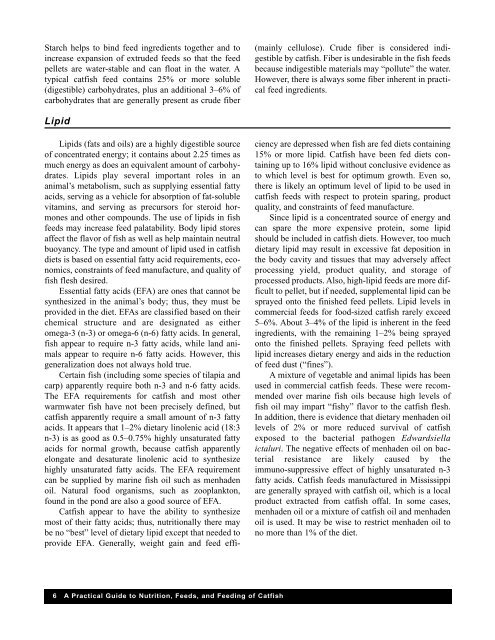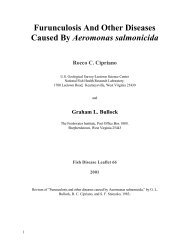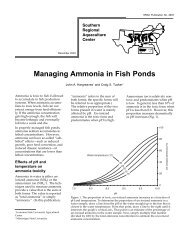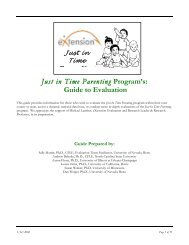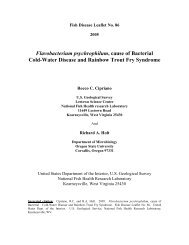A Practical Guide to Nutrition, Feeds, and ... - cop.eXtension.org
A Practical Guide to Nutrition, Feeds, and ... - cop.eXtension.org
A Practical Guide to Nutrition, Feeds, and ... - cop.eXtension.org
You also want an ePaper? Increase the reach of your titles
YUMPU automatically turns print PDFs into web optimized ePapers that Google loves.
Starch helps <strong>to</strong> bind feed ingredients <strong>to</strong>gether <strong>and</strong> <strong>to</strong><br />
increase expansion of extruded feeds so that the feed<br />
pellets are water-stable <strong>and</strong> can float in the water. A<br />
typical catfish feed contains 25% or more soluble<br />
(digestible) carbohydrates, plus an additional 3–6% of<br />
carbohydrates that are generally present as crude fiber<br />
Lipid<br />
Lipids (fats <strong>and</strong> oils) are a highly digestible source<br />
of concentrated energy; it contains about 2.25 times as<br />
much energy as does an equivalent amount of carbohydrates.<br />
Lipids play several important roles in an<br />
animal’s metabolism, such as supplying essential fatty<br />
acids, serving as a vehicle for absorption of fat-soluble<br />
vitamins, <strong>and</strong> serving as precursors for steroid hormones<br />
<strong>and</strong> other compounds. The use of lipids in fish<br />
feeds may increase feed palatability. Body lipid s<strong>to</strong>res<br />
affect the flavor of fish as well as help maintain neutral<br />
buoyancy. The type <strong>and</strong> amount of lipid used in catfish<br />
diets is based on essential fatty acid requirements, economics,<br />
constraints of feed manufacture, <strong>and</strong> quality of<br />
fish flesh desired.<br />
Essential fatty acids (EFA) are ones that cannot be<br />
synthesized in the animal’s body; thus, they must be<br />
provided in the diet. EFAs are classified based on their<br />
chemical structure <strong>and</strong> are designated as either<br />
omega-3 (n-3) or omega-6 (n-6) fatty acids. In general,<br />
fish appear <strong>to</strong> require n-3 fatty acids, while l<strong>and</strong> animals<br />
appear <strong>to</strong> require n-6 fatty acids. However, this<br />
generalization does not always hold true.<br />
Certain fish (including some species of tilapia <strong>and</strong><br />
carp) apparently require both n-3 <strong>and</strong> n-6 fatty acids.<br />
The EFA requirements for catfish <strong>and</strong> most other<br />
warmwater fish have not been precisely defined, but<br />
catfish apparently require a small amount of n-3 fatty<br />
acids. It appears that 1–2% dietary linolenic acid (18:3<br />
n-3) is as good as 0.5–0.75% highly unsaturated fatty<br />
acids for normal growth, because catfish apparently<br />
elongate <strong>and</strong> desaturate linolenic acid <strong>to</strong> synthesize<br />
highly unsaturated fatty acids. The EFA requirement<br />
can be supplied by marine fish oil such as menhaden<br />
oil. Natural food <strong>org</strong>anisms, such as zooplank<strong>to</strong>n,<br />
found in the pond are also a good source of EFA.<br />
Catfish appear <strong>to</strong> have the ability <strong>to</strong> synthesize<br />
most of their fatty acids; thus, nutritionally there may<br />
be no “best” level of dietary lipid except that needed <strong>to</strong><br />
provide EFA. Generally, weight gain <strong>and</strong> feed effi-<br />
6 A <strong>Practical</strong> <strong>Guide</strong> <strong>to</strong> <strong>Nutrition</strong>, <strong>Feeds</strong>, <strong>and</strong> Feeding of Catfish<br />
(mainly cellulose). Crude fiber is considered indigestible<br />
by catfish. Fiber is undesirable in the fish feeds<br />
because indigestible materials may “pollute” the water.<br />
However, there is always some fiber inherent in practical<br />
feed ingredients.<br />
ciency are depressed when fish are fed diets containing<br />
15% or more lipid. Catfish have been fed diets containing<br />
up <strong>to</strong> 16% lipid without conclusive evidence as<br />
<strong>to</strong> which level is best for optimum growth. Even so,<br />
there is likely an optimum level of lipid <strong>to</strong> be used in<br />
catfish feeds with respect <strong>to</strong> protein sparing, product<br />
quality, <strong>and</strong> constraints of feed manufacture.<br />
Since lipid is a concentrated source of energy <strong>and</strong><br />
can spare the more expensive protein, some lipid<br />
should be included in catfish diets. However, <strong>to</strong>o much<br />
dietary lipid may result in excessive fat deposition in<br />
the body cavity <strong>and</strong> tissues that may adversely affect<br />
processing yield, product quality, <strong>and</strong> s<strong>to</strong>rage of<br />
processed products. Also, high-lipid feeds are more difficult<br />
<strong>to</strong> pellet, but if needed, supplemental lipid can be<br />
sprayed on<strong>to</strong> the finished feed pellets. Lipid levels in<br />
commercial feeds for food-sized catfish rarely exceed<br />
5–6%. About 3–4% of the lipid is inherent in the feed<br />
ingredients, with the remaining 1–2% being sprayed<br />
on<strong>to</strong> the finished pellets. Spraying feed pellets with<br />
lipid increases dietary energy <strong>and</strong> aids in the reduction<br />
of feed dust (“fines”).<br />
A mixture of vegetable <strong>and</strong> animal lipids has been<br />
used in commercial catfish feeds. These were recommended<br />
over marine fish oils because high levels of<br />
fish oil may impart “fishy” flavor <strong>to</strong> the catfish flesh.<br />
In addition, there is evidence that dietary menhaden oil<br />
levels of 2% or more reduced survival of catfish<br />
exposed <strong>to</strong> the bacterial pathogen Edwardsiella<br />
ictaluri. The negative effects of menhaden oil on bacterial<br />
resistance are likely caused by the<br />
immuno-suppressive effect of highly unsaturated n-3<br />
fatty acids. Catfish feeds manufactured in Mississippi<br />
are generally sprayed with catfish oil, which is a local<br />
product extracted from catfish offal. In some cases,<br />
menhaden oil or a mixture of catfish oil <strong>and</strong> menhaden<br />
oil is used. It may be wise <strong>to</strong> restrict menhaden oil <strong>to</strong><br />
no more than 1% of the diet.


